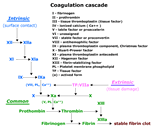Prothrombin time
 The prothrombin time or PT is an assessment of the extrinsic and common pathways. The PT is the specific and only lab test used to measure the effectiveness of coumarin-type anticoagulant drugs, such as warfarin sodium (Coumadin). The most common methods to report the PT are time (in seconds) and the International Normalized Ratio (INR).
The prothrombin time or PT is an assessment of the extrinsic and common pathways. The PT is the specific and only lab test used to measure the effectiveness of coumarin-type anticoagulant drugs, such as warfarin sodium (Coumadin). The most common methods to report the PT are time (in seconds) and the International Normalized Ratio (INR).
- The PT reported as time in seconds, represents how long a plasma sample takes to clot after a mixture of thromboplastin and calcium are added. If the patient's blood has less prothrombin than the normal ( or "control"), or a decrease in other clotting factors that affect the prothrombin time, the PT time in seconds will be longer than the control values. Normal values for PT time reported in seconds is between 11 and 13 seconds, depending on the method used by the laboratory.
- The World Health Organization instituted the INR, a uniform value in which PT is expressed as a ratio, to give PT values a consistent basis of comparison from laboratory to laboratory. In the last few years, the INR is becoming a more common method of measuring and reporting the PT (Shikadar, 2023). Targets for the INR vary, depending on the reason for anticoagulation. For example, a patient having hip surgery, who is being anticoagulated to prevent deep vein thrombosis, may have a target INR of between 2 and 3. To prevent arterial thrombosis in a patient with an artificial heart valve, the INR therapeutic goal may be in the 2.5 to 3.5 range.
 As oral warfarin (Coumadin) has a relatively long onset of action, it takes several days of therapy to achieve a therapeutic level. When a patient will be managed on oral coumadin, he or she may be given both heparin and coumadin, and then heparin is discontinued. Suppose a PT is increased beyond a therapeutic level. In that case, the coumadin dose may be reduced, or the patient may be given parenteral Vitamin K. Drugs that increase or prolong the PT time include antibiotics, cimetidine (Tagamet), salicylates, and sulfonamides. Barbiturates, oral contraceptives, and Vitamin K in multivitamin preparations or in liquid nutritional supplements decrease the PT time.
As oral warfarin (Coumadin) has a relatively long onset of action, it takes several days of therapy to achieve a therapeutic level. When a patient will be managed on oral coumadin, he or she may be given both heparin and coumadin, and then heparin is discontinued. Suppose a PT is increased beyond a therapeutic level. In that case, the coumadin dose may be reduced, or the patient may be given parenteral Vitamin K. Drugs that increase or prolong the PT time include antibiotics, cimetidine (Tagamet), salicylates, and sulfonamides. Barbiturates, oral contraceptives, and Vitamin K in multivitamin preparations or in liquid nutritional supplements decrease the PT time.
When therapy with coumadin is begun, the dose is guided by monitoring the prothrombin time. Therapeutic levels are generally between 1 1/2 and 2 times normal, depending on the patient's need for anticoagulation. Expressed in terms of the INR, the range is between 2.0 and 3.0. A usual dose requirement is between 5 to 7.5 mg. daily. In some patients with coumadin resistance, the dosage may be much higher. If a patient with a prolonged PT must have surgery, the PT must be brought within a normal range before surgery. This is often done with Vitamin K injections. Whole blood or fresh frozen plasma should be available for the surgical patient with an abnormal PT.
Reference
Shikdar S, Vashisht R, Bhattacharya PT. International Normalized Ratio (INR) [Updated 2023 May 1]. In: StatPearls [Internet]. Treasure Island (FL): StatPearls Publishing; 2024 Jan-. Available from: https://www.ncbi.nlm.nih.gov/books/NBK507707/
© RnCeus.com
 As oral warfarin (Coumadin) has a relatively long onset of action, it takes several days of therapy to achieve a therapeutic level. When a patient will be managed on oral coumadin, he or she may be given both heparin and coumadin, and then heparin is discontinued. Suppose a PT is increased beyond a therapeutic level. In that case, the coumadin dose may be reduced, or the patient may be given parenteral Vitamin K. Drugs that increase or prolong the PT time include antibiotics, cimetidine (Tagamet), salicylates, and sulfonamides. Barbiturates, oral contraceptives, and Vitamin K in multivitamin preparations or in liquid nutritional supplements decrease the PT time.
As oral warfarin (Coumadin) has a relatively long onset of action, it takes several days of therapy to achieve a therapeutic level. When a patient will be managed on oral coumadin, he or she may be given both heparin and coumadin, and then heparin is discontinued. Suppose a PT is increased beyond a therapeutic level. In that case, the coumadin dose may be reduced, or the patient may be given parenteral Vitamin K. Drugs that increase or prolong the PT time include antibiotics, cimetidine (Tagamet), salicylates, and sulfonamides. Barbiturates, oral contraceptives, and Vitamin K in multivitamin preparations or in liquid nutritional supplements decrease the PT time. The prothrombin time or
The prothrombin time or